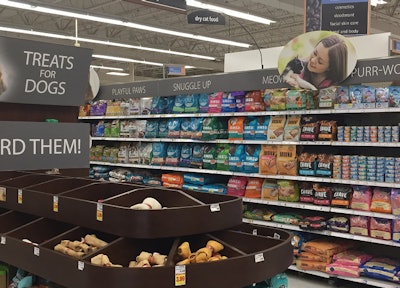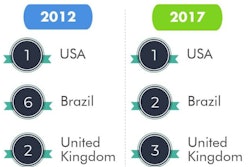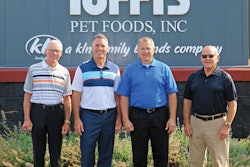
The continuing growth of ecommerce is changing and even disrupting many markets and product categories, including pet food. That’s especially the case with the US pet specialty channel.
Yet ecommerce is not the only threat faced by pet retailers. A growing number of pet food brands have figured out how to take features and claims coveted by many pet owners today and previously available only in products sold in pet specialty stores – natural, premium, clean label and others – and offer them at a price point that works in grocery stores and other mass retailers.
This is leading to what Jared Koerten, senior research analyst for Euromonitor, characterized as a “stunning and historic trend reversal”: pet food sales growth in the US mass market channel will very likely outpace growth in US pet specialty for 2017, once final data for last year is available. After sales in pet specialty soared 124 percent from 2003 to 2016, versus 48 percent cumulative growth in mass, projected 2017 data show just over 2 percent growth for mass versus about 1.5 percent for pet specialty. That’s not much of a difference, but it is a reversal, and it’s also significant because the mass market’s dollar share of pet food in 2017 was 53 percent, while pet specialty’s was 34 percent.
History of mass premiumization of pet food
Koerten presented these data and insights during the American Feed Industry Association’s annual pet food conference in Atlanta, Georgia, USA. His presentation included an interesting timeline of the “mass premiumization” of pet food, starting all the way back in 2000 when Iams, which had been acquired by Procter & Gamble just the year before, infuriated many pet retailers (and some pet owners) by expanding distribution of its premium pet foods, until then sold exclusively in pet stores, into the mass channel. And not just incrementally; Koerten described a “massive rollout” involving a leap from 20,000 to 45,000 retail outlets and 3,000 trucks leaving P&G warehouses with Iams products in just one day.
Besides the backlash by pet retailers, the move also resulted in bad PR, including rumors that Iams product quality had declined. Perhaps that’s why eight years passed before another company tried, but this time with a new brand launch — when Ainsworth Pet Nutrition launched Rachael Ray Nutrish, essentially a superpremium line, into the mass channel in 2008. It has been an unqualified success: Since its launch, the brand has experienced a compound annual growth rate of 48.6 percent, culminating in 2017 sales of about US$700 million, Koerten said.
That success has attracted many followers, including a few relaunches (Purina Beyond, for instance) but mainly brands adopting the earlier tactic from Iams and P&G: Mars moving Nutro into mass with a big clean label push, J.M. Smucker’s moving Nature’s Recipe and Blue Buffalo taking its Blue Life Protection Formula line into four mass retailers in August 2017, to name a few examples.
Convenience and time-saving are key
As one reason for these moves, and pet owners’ response to them, Koerten presented data showing that the amount of time consumers spend shopping for goods has decreased 12 percent since 2004, to an average of about 150 minutes per week. People today are increasingly busy and don’t want to make multiple shopping stops; if they can find what they perceive as high-quality and premium foods for their pets in the same place they’re buying food for their human family members — often a grocery store, club store or mass retailer like Target or Walmart — it’s almost a no-brainer for many.
Many others, of course, are skipping the in-person purchasing time and inconvenience altogether and buying their pet food online. Koerten’s data indicated about 48 percent growth in 2017 for US dog and cat food ecommerce sales, reaching about US$2 billion.
According to a Packaged Facts consumer survey conducted last fall, 17 percent of US dog owners and 14 percent of US cat owners had purchased pet food through a website for home delivery in the past 12 months, wrote David Lummis, senior pet analyst, in Pet Product News magazine. And, despite the well-known penchant for millennials to do anything and everything online, the percentage of baby boomers (55 to 64 years old) surveyed buying pet food online was higher: 21 percent for dog owners and 18 percent for cat, vs. 19 and 17 percent, respectively, for respondents aged 25 to 34.
This is all contributing to flat pet food sales growth in the US pet specialty channel, according to GfK.
Premiumization: value growth, not volume
Another ongoing outcome of the spread of pet food premiumization into channels other than pet specialty is a continuing decline of US volume sales (tonnage) versus value sales (dollars). Koerten mentioned this, attributing the decrease in volume also to the rising popularity and ownership of smaller dogs.
His data was corroborated by the 2018 Alltech Global Feed Survey, released on January 25. The report revealed that while 2017 dry pet food production grew about 12 percent globally over 2016 numbers, to 28.1 million tons, the growth came mainly from developing regions. North America’s volume was flat, said Aidan Connolly, Alltech’s chief innovation officer, though it still represented the highest value due to premiumization.


















